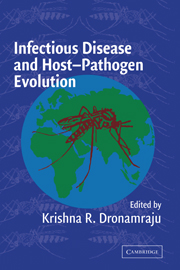Book contents
- Frontmatter
- Contents
- List of Contributors
- Introduction
- PART ONE J. B. S. HALDANE
- 1 Haldane's Ideas in Biology with Special Reference to Disease and Evolution
- 2 J. B. S. Haldane and the Malaria Hypothesis
- PART TWO MALARIAL PARASITES
- PART THREE OTHER PARASITES
- PART FOUR GENETIC AND EVOLUTIONARY CONSIDERATIONS
- Index
- Plate Section
- References
2 - J. B. S. Haldane and the Malaria Hypothesis
Published online by Cambridge University Press: 10 August 2009
- Frontmatter
- Contents
- List of Contributors
- Introduction
- PART ONE J. B. S. HALDANE
- 1 Haldane's Ideas in Biology with Special Reference to Disease and Evolution
- 2 J. B. S. Haldane and the Malaria Hypothesis
- PART TWO MALARIAL PARASITES
- PART THREE OTHER PARASITES
- PART FOUR GENETIC AND EVOLUTIONARY CONSIDERATIONS
- Index
- Plate Section
- References
Summary
In 1948, J. B. S. Haldane proposed that the selective agent for maintaining the high frequency of thalassemia in the Mediterranean races might be malaria. Thus was born what, in the human hemoglobin field at least, later became known as the malaria hypothesis. In this short essay, I examine the origins of this hypothesis, ask how it has stood the test of time, and summarize the broader field of research which it has spawned and which attempts to understand the genetic basis of variability in individual susceptibility to infection in general. Many of these issues have been reviewed in detail over recent years and are only summarized here.
THE MALARIA HYPOTHESIS
Although the first clinical descriptions of the thalassemias appeared in the 1920's, it only became apparent that these conditions follow a Mendelian recessive or co-dominant pattern of inheritance in the period immediately preceding World War II. At this time relatively simple methods for carrier screening became available and hence it was possible to carry out population studies to attempt to determine gene frequencies.
The extraordinarily high frequency of the genes for thalassemia puzzled population geneticists, particularly those who had become interested in mutation rates as a result of their studies of the survivors of the atomic bombs that had been dropped on Hiroshima and Nagasaki. Extensive studies of gene frequencies of thalassemia were carried out quite independently in the 1940's by workers in the United States and Italy (Neel and Valentine, 1947; Silvestroni and Bianco, 1947), but because of lack of communication during the war and its aftermath it was not until the early 1950's that this broad body of work could be integrated and assessed.
- Type
- Chapter
- Information
- Infectious Disease and Host-Pathogen Evolution , pp. 18 - 36Publisher: Cambridge University PressPrint publication year: 2004
References
- 6
- Cited by



